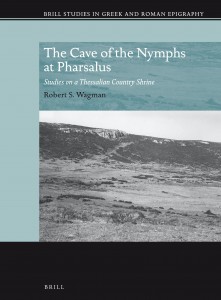In print 2015:
The Cave of the Nymphs at Pharsalus. Studies on a Thessalian Country Shrine
Brill Studies in Greek and Roman Epigraphy 6. Brill: Leiden and Boston 2015.
From the back cover: Cave of the Nymphs at Pharsalus is the first book-length study of one of Greece’s most cited nymph sanctuaries. The volume includes a revised catalog, extensive new commentaries on the cave’s famous inscriptions, and a first-time investigation of the site’s topographical and archaeological layout. Also known as Alogopati or Karapla cave, the Pharsalian shrine holds a special place among ancient nymph caves as the only such site to feature an inscribed poetic chronicle of the shrine’s foundation and its founder, the mysterious nymph worshipper Pantalces. Based on years of fieldwork and archival research, Cave of the Nymphs challenges some commonly held views about the origin of this rock-cut ‘tale’ and offers a fresh perspective for understanding the Pharsalian cave in its proper historical context.
Preview in Google Books
Reviewed in: Journal of Greek Archaeology 6, 2021, 413-418 (M. Mili).
In preparation:
Beliefs of Modern Greece. An Annotated Translation of Leo Allatius’ De graecorum hodie quorundam opinationibus
The 17th century treatise De graecorum hodie quorundam opinationibus (‘On the Beliefs of Some Greeks Today’) is considered to be one of our foremost sources on Medieval and Early Modern Greek folklore. Written by the celebrated humanist and keeper of the Vatican Library Leo Allatius (1587-1669), it holds a special place in Western literature as the earliest known scholarly treatment of vampire superstition. Never translated into a modern language, until now this work has been accessible to modern audiences only through excerpts quoted by later authors such as J.C. Lawson (Modern Greek Folklore and Ancient Greek Religion: a Study in Survivals, 1910) and Montague Summers (The Vampire: His Kith and Kin, 1928). Beliefs of Modern Greece is the first complete translation of the 1645 edition, accompanied by a commentary and an annotated Latin text.
| LINK TO ONLINE TRANSLATION | LINK TO SAMPLE COMMENTARY |
